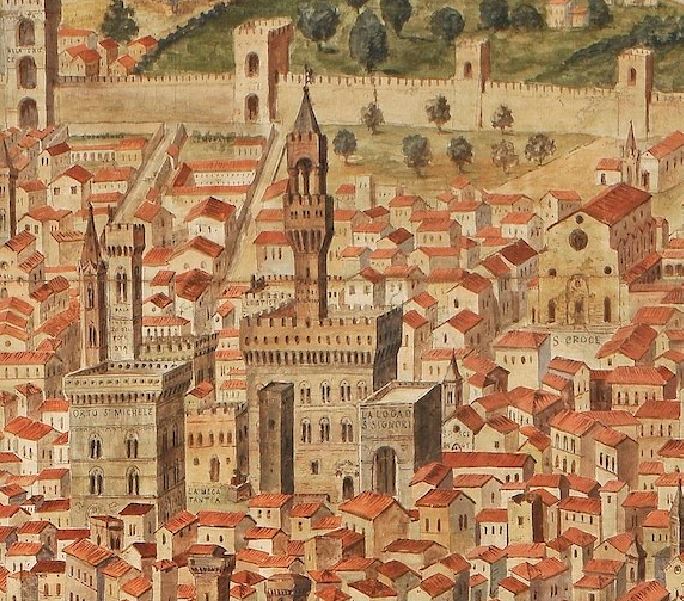La Veduta della Catena: Florence’s “Chain Map”.
In 1403, Leonardo Bruni wrote the Laudatio florentinae Urbis, or the Oration and Praise of the City of Florence. Emulating the ancient author Aristedes’ Panathenicus (Panegyric to Athens), Bruni set the humanist movement within a definite temporal and spatial framework, exalting Florence as a place which cultivated excellence, learning and good fortune: “There is a wise old saying that to be happy one must first of all have an illustrious and renowned native land” (Bruni, Dialogues).
The Chain Map of Florence, dating to the 1470s, is derived from an original woodcut showing a birds-eye view of the city. However, this is much more than an objective map, but displays a subjective view of the city which echoes the literary ideal created by Bruni in his writings. For the humanist, Florence was a place of beauty which facilitated the flourishing of humanism and disseminated it to the rest of Italy: “Finally, Humanistic studies themselves, which are the best and most distinguished branches of learning and the most appropriate to humankind, being essential to private life as well as to public life, were embellished by our native literary tradition and came, with the support of our city, to spread throughout Italy” (Bruni, Funeral Oration for Nanni Strozzi).
For Bruni, architecture contained essential messages of space and time, and a city’s buildings gave insight into the cultural condition of the city and its people. In this way, the Chain Map takes on a greater significance. The walls of the city which, even by the 13th century, had spread across the river, form a mandorla, an almond-shaped vessel of sorts in which Christ was traditionally depicted in images of the Last Judgement. The spiritual significance this affords to the city is also reflected in the central position of the Duomo, which in reality is not found at the very centre of the city. This depiction, however, enlarges the religious and civic structures in the city, externalising the beauty which Bruni argued was inherent in Florence’s streets and people (a phenomenon unique to Florence, according to Bruni).
This view of Florence can be seen as a humanistic construction of an ideal city, whose inner condition reflects the remarkable scene a visitor was presented with as they approached from the hills.
Reference: Griffiths, Hankins & Thompson eds. The Humanism of Leonardo Bruni: Selected Texts. Arizona: Arizona State University Press, 1987.
Francesco & Raffaello Petrini, Lav Veduta della Catena, 1887, Palazzo Vecchi Museum.
(Images: artsandculture.google.com)
Further Reading: Ronald Witt. In the Footsteps of the Ancients: The Origins of Humanism from Lovato to Bruni. Leiden, Boston: Brill, 2000.
Posted by: Matthew Whyte


